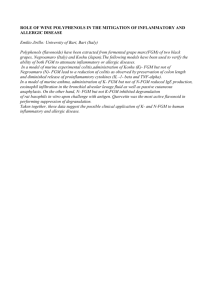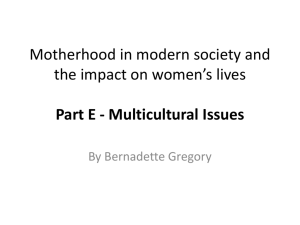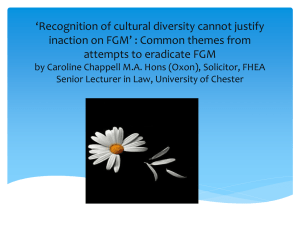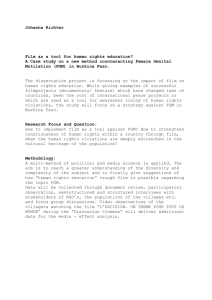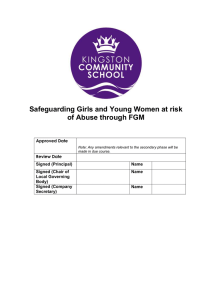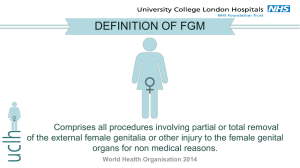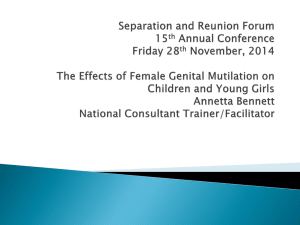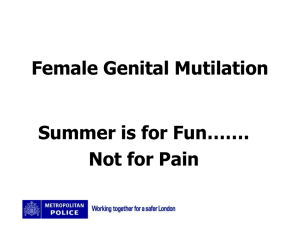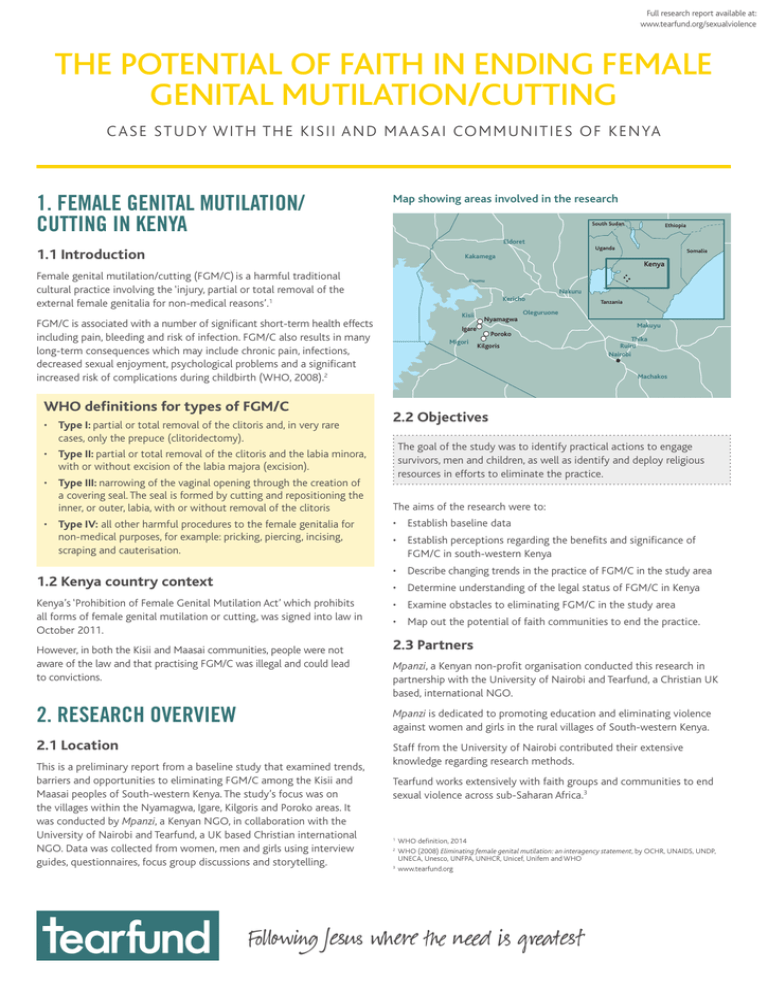
Full research report available at:
www.tearfund.org/sexualviolence
THE POTENTIAL OF FAITH IN ENDING FEMALE
GENITAL MUTILATION/CUTTING
C ASE STUDY WITH THE KISII AND MAASAI COMMUNITIES OF KENYA
1. FEMALE GENITAL MUTILATION/
CUTTING IN KENYA
Map showing areas involved in the research
South Sudan
Ethiopia
Eldoret
Uganda
1.1 Introduction
Somalia
Kakamega
Kenya
Female genital mutilation/cutting (FGM/C) is a harmful traditional
cultural practice involving the ‘injury, partial or total removal of the
external female genitalia for non-medical reasons’.1
Kisumu
Nakuru
Kericho
Kisii
FGM/C is associated with a number of significant short-term health effects
including pain, bleeding and risk of infection. FGM/C also results in many
long-term consequences which may include chronic pain, infections,
decreased sexual enjoyment, psychological problems and a significant
increased risk of complications during childbirth (WHO, 2008).2
WHO definitions for types of FGM/C
• Type I: partial or total removal of the clitoris and, in very rare
cases, only the prepuce (clitoridectomy).
Migori
• Type IV: all other harmful procedures to the female genitalia for
non-medical purposes, for example: pricking, piercing, incising,
scraping and cauterisation.
Poroko
Kilgoris
Makuyu
Thika
Ruiru
Nairobi
Machakos
2.2 Objectives
The goal of the study was to identify practical actions to engage
survivors, men and children, as well as identify and deploy religious
resources in efforts to eliminate the practice.
• Type II: partial or total removal of the clitoris and the labia minora,
with or without excision of the labia majora (excision).
•
Type III: narrowing of the vaginal opening through the creation of
a covering seal. The seal is formed by cutting and repositioning the
inner, or outer, labia, with or without removal of the clitoris
Nyamagwa
Igare
TanzaniaNyeri
Oleguruone
The aims of the research were to:
• Establish baseline data
•Establish perceptions regarding the benefits and significance of
FGM/C in south-western Kenya
• Describe changing trends in the practice of FGM/C in the study area
1.2 Kenya country context
•Determine understanding of the legal status of FGM/C in Kenya
Kenya’s ‘Prohibition of Female Genital Mutilation Act’ which prohibits
all forms of female genital mutilation or cutting, was signed into law in
October 2011.
However, in both the Kisii and Maasai communities, people were not
aware of the law and that practising FGM/C was illegal and could lead
to convictions.
2. RESEARCH OVERVIEW
• Examine obstacles to eliminating FGM/C in the study area
• Map out the potential of faith communities to end the practice.
2.3 Partners
Mpanzi, a Kenyan non-profit organisation conducted this research in
partnership with the University of Nairobi and Tearfund, a Christian UK
based, international NGO.
Mpanzi is dedicated to promoting education and eliminating violence
against women and girls in the rural villages of South-western Kenya.
2.1 Location
This is a preliminary report from a baseline study that examined trends,
barriers and opportunities to eliminating FGM/C among the Kisii and
Maasai peoples of South-western Kenya. The study’s focus was on
the villages within the Nyamagwa, Igare, Kilgoris and Poroko areas. It
was conducted by Mpanzi, a Kenyan NGO, in collaboration with the
University of Nairobi and Tearfund, a UK based Christian international
NGO. Data was collected from women, men and girls using interview
guides, questionnaires, focus group discussions and storytelling.
Staff from the University of Nairobi contributed their extensive
knowledge regarding research methods.
Tearfund works extensively with faith groups and communities to end
sexual violence across sub-Saharan Africa.3
WHO definition, 2014
WHO (2008) Eliminating female genital mutilation: an interagency statement, by OCHR, UNAIDS, UNDP,
UNECA, Unesco, UNFPA, UNHCR, Unicef, Unifem and WHO
3
www.tearfund.org
1
2
Following Jesus where the need is greatest
3. Summary of research findings
c) Cultural identity
The findings indicate that the practice of FGM/C is still highly regarded
and favoured as part of the social and cultural way of life among the
Maasai and Kisii ethnic communities in rural south-western Kenya.
•FGM/C is significant as a cultural identity marker for both Kisii
and Maasai girls and women. The Kisii neighbours – the Luo ethnic
community – does not practice FGM/C, and so the practice is
considered an essential identity marker for Kisii girls.
Respondents suggested that religion is a way of life, and hence the social
and cultural practice of FGM/C is woven into their faith, such that religious
practices such as prayer and worship, are embedded into FGM/C activities.
There is almost no knowledge and awareness regarding the
implementation of the Kenyan government’s ‘Prohibition of Female
Genital Mutilation (FGM) Act’ which was signed into law in October 2011.
Key points
•FGM/C in both the Kisii and Maasai communities is perceived as a
rite of passage, with some girls voluntarily undergoing FGM/C.
•There have been some changes in the practise of FGM/C over time
but social beliefs about the benefit of the practise, still sustain it.
•Most respondents were concerned about derogatory terms used for
‘uncut’ girls. Some likened them to the Luo (Omogere bosa), and they
were considered an insult to the notion of girlhood and womanhood,
and a major threat to being a full family and community member.
“I don’t want my daughter to grow up like Omogere bosa and be
insulted all the time.”
Respondent during focus group discussions
3.2 Changes in FGM/C trends
•A legal framework opposing FGM/C exists, but communities are
not aware of it.
•Faith plays an important role in Kisii communities and is often part
of FGM/C activities.
•There is considerable potential to make use of faith as a tool to
prevent and eliminate FGM/C.
3.1 Key Perceptions about FGM/C
73% of respondents suggested that FGM/C was a significant practice
for both the Kisii and Maasai communities. Of these, 94% of the female
respondents reported that they had voluntarily undergone FGM/C
between the ages of 10-19 as a rite of passage. There were a number of
key perceptions that emerged:
Women talking about trends in FGM/C . Photo: Mpanzi.
a) Respect for girls and a rite of passage
Respondents suggested that the practice of FGM/C had changed over time:
•Both male and female respondents suggested that traditionally,
FGM/C brought respect for the girls involved, who would then be
considered mature, responsible and ready for marriage.
•There was a considerable reduction of girls undergoing the practice
because of the increased knowledge of its health risks. Over 98% all
of female adults interviewed had undergone the practice, while only
60% of the girls had undergone it.
•Most respondents said that FGM/C was a significant rite of passage
from childhood to adulthood. During the seclusion period, young
women received training to introduce them to the required duties of
married women. The Maasai did not consider FGM/C as ‘harmful’ but
as a valued indigenous practise that brought blessing and honour for
young girls as they grew into adulthood.
•Often girls who underwent the practice still attended school and were
too young for marriage, but it was considered a stage in life to be
proud of and girls were eager to take part.
“When we ‘circumcise’ Maasai girls, we train them to be good women.
And when we circumcise Maasai boys, we train them to be good moran
warriors who are blessed by the Laibon (A spiritual prophet).”
Respondent from Maasai community
b) Prevention of promiscuity
•FGM/C was believed to control sexual desire thus preventing
promiscuity and maintaining self-control for married women.
• ‘Uncut’ women are segregated and stigmatised as a result.
•In recent years, most girls underwent the practice much earlier
(between the age of 7 to 12) and it was often carried out during
school breaks.
•Women and girls who had undergone the practice said it brought
them respect and made them fit in to their communities.
•Most girls underwent the practice as a family (with siblings, cousins or
extended family members), rather than within community groups.
•Increasingly, the cutting was done by a medical practitioner within a
homestead or in a health clinic.
•Public festivities such as beer parties, the sharing of food and public
singing and processions were no longer common. But village parties
were held with close family members and friends especially after the
healing period.
•Following FGM/C, girls continued with their education, although some
would leave before, or soon after, completing grade 8 to get married.
Some cultural and social activities had continued with the practice. Of
those interviewed, 89% of respondents said religious practices such as
prayer, thanksgiving and worship continued to be a central part of FGM/C
activities. Spiritual and religious leaders offered blessings to the initiates
when requested by family or community members. However, FGM/C was
never discussed or debated. Often FGM/C was practiced alongside male
circumcision for children of the same age-set.
4. Kenyan law regarding FGM/C
6. Recommendations for action
Eliminating FGM/C in rural villages among the Kisii and Maasai of
Southwestern Kenya is a challenging task for government or religious
institutions to achieve alone. However faith groups have considerable
potential to help prevent and end FGM/C by using their resources
effectively and appropriately. The study highlights the resources that
could be used towards this:
Spiritual texts
Over 58% respondents noted that FGM/C was not part of their religious texts
and that there was therefore no religious mandate to continue the practice.
Respondents who were against the practice of FGM/C, suggested that
the Church and Mosques were institutions that could play a significant
part in eliminating the practice. One respondent recited a biblical
text asserting that in the book of Romans 2:29, it states that: “Real
circumcision is in the heart, a thing not of the letter, but of the spirit.”
Girls who undergo FGM/C will sometimes leave school prematurely to get married. Photo: Mpanzi.
Over 85% of the respondents were unaware of Kenya’s ‘Prohibition
of Female Genital Mutilation Act,’ which prohibits all forms of female
genital mutilation or cutting and was signed into law in October 2011.
About 14% of the respondents said that they knew that there was a
law that criminalized FGM/C but were unaware of its details. They had
learned about the law through public meetings called barazas that were
organised by local chiefs, but they thought this was information about
the national government’s stand and would not have serious implications
on local people’s culture.
Most participants did not understand that according to Kenyan law,
the practice of FGM/C was illegal, and they were not aware of any
convictions. Respondents were unaware that it was criminal to solicit
services for the purposes of FGM/C, or to use derogatory remarks against
a woman or girl who had not undergone the practice.
5. Challenges to eliminating FGM/C
Some major obstacles to eliminating FGM/C in rural villages emerged
from this study:
•FGM/C is still significant within the social and spiritual practices of
rural villages and is not considered harmful.
•FGM/C is perceived as essential to gaining adulthood to a woman or
girl. It is seen as conveying gender identity; creating and maintaining
bonding for women.
•Although the practice has changed over time, it is sustained by
emotional attachments, deep-rooted attitudes and beliefs about
its benefits.
•Individuals and community leaders are unaware of the existing
national laws that prohibit FGM/C. The law has not been enforced or
adapted to local contexts.
•FGM/C is normalised and embedded into religious life and activities.
As a result, religion, like culture and institutions such as the family, is a
socialising and enabling agent.
•Religious leaders and congregations rarely discuss matters relating to
FGM/C in churches or religious gatherings.
Religious explanations
Respondents suggested that religious leaders such as pastors, priests and
Imams could make religious arguments about preventing FGM/C that
were linked to the Kenyan law which made it illegal – through the use of
homilies, fatwas, preaching, teaching and prayer.
Religious groups
Respondents identified religious groups including youth groups, Catholic
Women Associations (Mama Mkatoliki), Dorcas (Seventh Day Adventist
women’s groups), Quakers, and the Anglican Mothers Union, which could
help provide structures and networking for campaigning messaging to
eliminate FGM/C. These groups usually meet each week and have links
with national and international networks. They would provide useful
avenues for discussion and for sharing information.
Health Centres
Respondents suggested that village health centres run by religious groups
were well trusted, even by the government. They could be used to provide
education, training and knowledge particularly on the health implications
of FGM/C. The health centres had skilled employees and facilities that
would provide support and training for prevention. They were also able to
respond in the event of an emergency following FGM/C such as bleeding.
Large potential for impact
Respondents suggested that because faith was such an integral
part of village life, any efforts to eliminate FGM/C that involved all
congregations would effectively reach many people. The right messages
needed to be developed to resonate with the spiritual and cultural values
of the people in order to bring about organised change.
7. Next steps
Mpanzi, Tearfund and the University of Nairobi will share these research
findings with a wide range of stakeholders, including faith leaders,
government and other organisations committed to ending FGM/C. This
will be the first step in building collaboration and commitment towards
developing an effective response that brings the practice of FGM/C to an
end in these communities in Kenya.
Tearfund is a Christian relief and development agency building a global
network of local churches to help eradicate poverty.
Tearfund has 10 years’ experience working through church-based
partners in the response to sexual violence.
Acknowledgments
This research was conducted by Mpanzi and supported by Tearfund. We would like to acknowledge the following people who
participated in the research:
Researchers
Dr Jacqueline Ogega, Prof. Simiyu Wandibba, Catherine Kerubo, Jane Mandina, Pamela Mokua and Marcella Moraa Ogega
Website: www.mpanzi.org
Email:info@mpanzi.org
In partnership with:
Tearfund: Veena O’Sullivan, Head of sexual violence unit
Email: veena.osullivan@tearfund.org
Editor: Isabel Carter
Following Jesus where the need is greatest
www.tearfund.org
100 Church Road, Teddington TW11 8QE
Challenge House, 29 Canal Street, Glasgow G4 0AD
Tŷ Catherine, Capel Cildwrn, Llangefni, Ynys Môn LL77 7NN
241 Newtownards Road, Belfast BT4 1AF
enquiries@tearfund.org 0845 355 8355
Registered Charity No. 265464 (England and Wales)
Registered Charity No. SC037624 (Scotland)
31337(1114)

